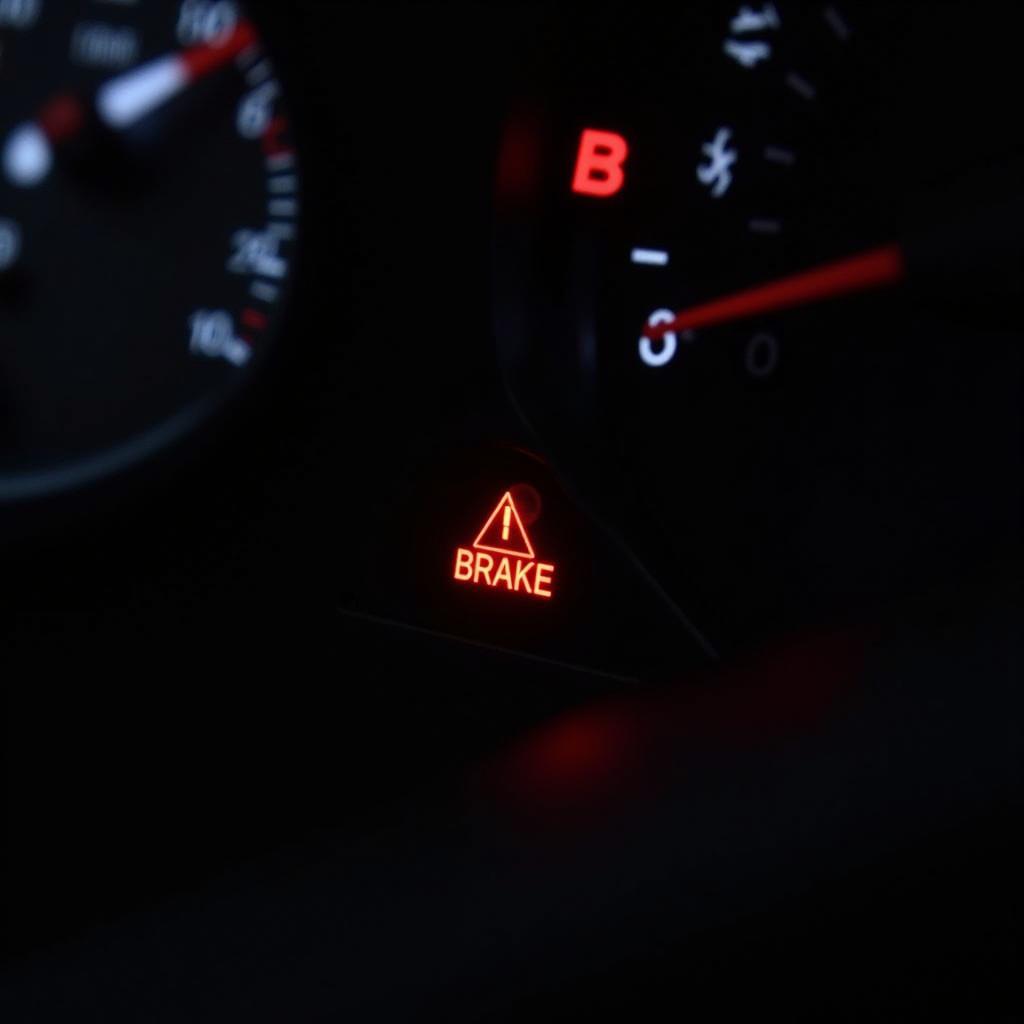The brake system warning light, a universal symbol found on your dashboard, illuminates to signal potential issues within your vehicle’s braking system. This light, often depicted as a red circle with an exclamation mark or the word “BRAKE” in the center, serves as an early warning, prompting you to address the underlying problem before it escalates into a safety hazard. Ignoring this warning could have serious consequences, potentially compromising your ability to stop safely.
Understanding the Brake Warning Light
While the appearance of the brake warning light might vary slightly across different car models, its core message remains consistent: attention required within your brake system. It’s crucial to remember that this warning light doesn’t pinpoint a specific issue; rather, it acts as a general indicator of a potential malfunction within the complex network of components that make up your vehicle’s braking system.
 Brake warning light on a car dashboard
Brake warning light on a car dashboard
Common Causes of the Brake Warning Light
The illumination of the brake system warning light can stem from various factors. Here’s a breakdown of some of the most frequent culprits:
1. Engaged Parking Brake
One of the most straightforward and easily resolvable causes is an engaged parking brake. Before diving into more complex scenarios, ensure your parking brake is fully released. Often, a simple oversight can trigger the warning light.
2. Low Brake Fluid Level
Brake fluid, the lifeblood of your braking system, is responsible for transmitting the force applied to the brake pedal to the wheels, ultimately slowing down or stopping your vehicle. A low brake fluid level often indicates a leak within the system, a problem that requires immediate attention.
 Checking brake fluid level in a car
Checking brake fluid level in a car
3. Worn Brake Pads
Brake pads, designed to wear down over time, play a critical role in generating the friction needed to stop your vehicle. As they wear down to a certain point, a sensor within the brake pad triggers the warning light, signaling the need for replacement.
4. Malfunctioning ABS System
Modern vehicles are often equipped with an Anti-lock Braking System (ABS), a safety feature designed to prevent wheel lockup during hard braking. A malfunction within the ABS system, often indicated by a separate ABS warning light, can also trigger the brake system warning light.
toyota corolla 2008 brake system warning light
5. Brake System Malfunctions
Beyond these common causes, the brake system warning light can also indicate more complex issues such as a faulty brake master cylinder, problems within the brake lines, or issues with the brake booster. Diagnosing these problems often requires specialized equipment and expertise.
What to Do When the Brake Warning Light Comes On
“The moment you notice the brake system warning light illuminating, it’s crucial to prioritize safety,” advises John Miller, Senior Automotive Engineer at Car Clinic. “Pulling over as soon as it’s safe to do so and assessing the situation is paramount.”
Here’s a step-by-step guide on how to respond:
- Safety First: Pull over safely away from traffic.
- Check Your Parking Brake: Ensure it’s fully released.
- Visual Inspection: Carefully check for visible brake fluid leaks.
- Consult Your Owner’s Manual: Refer to your car’s manual for model-specific information.
- Seek Professional Help: If the light persists or you suspect a serious issue, contact a qualified mechanic immediately.
brake hydraulic system red warning light
Preventing Brake System Issues
Regular vehicle maintenance plays a crucial role in preventing brake system problems. Here are some preventative measures:
- Regular Brake Inspections: Adhere to your car manufacturer’s recommended brake inspection intervals.
- Timely Brake Fluid Flush: Replace your brake fluid according to the schedule outlined in your owner’s manual.
- Quality Brake Pads: Invest in high-quality brake pads to ensure optimal performance and longevity.
The Importance of Addressing the Brake Warning Light
Ignoring a glowing brake system warning light can have dire consequences, potentially leading to brake failure and compromising your safety and the safety of others on the road. Promptly addressing any issues with your braking system is not just about maintaining your vehicle; it’s about ensuring everyone’s well-being.
anti lock brake system warning light
FAQs About the Brake System Warning Light
What Does It Mean If the Brake Warning Light Is Flashing?
A flashing brake warning light often signifies a more serious issue, potentially a malfunction within the ABS system or a critical brake fluid leak.
Can I Drive with the Brake Warning Light On?
While it might be possible to drive a short distance with the brake warning light on, it’s highly discouraged. Continuing to drive could exacerbate the problem and lead to hazardous situations.
what does the brake system warning light or gauge indicate
How Much Does It Cost to Fix a Brake System Warning Light?
The cost of repair depends entirely on the underlying cause. Simple fixes, like adding brake fluid, can be relatively inexpensive, while more complex repairs can be significantly more costly.
How Can I Prevent My Brake Warning Light From Coming On?
Regular vehicle maintenance, including timely brake fluid flushes, brake inspections, and the use of quality brake pads, can significantly reduce the risk of brake system problems.
abs and brake system warning lights
Conclusion
Understanding the significance of the brake system warning light and responding proactively can be the difference between a minor inconvenience and a major safety hazard. Never ignore this crucial warning; prioritize your safety and seek professional assistance whenever necessary to keep your vehicle’s braking system in optimal condition.

